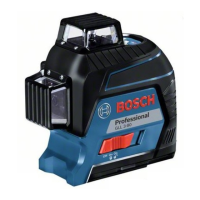-9-
Influences on Accuracy
The ambient temperature has the greatest
influence. Especially temperature differences
occurring from the ground upward can divert
the laser beam.
Because the largest difference in temperature
layers is close to the ground, the tool
should always be mounted on a tripod when
distances exceeding 20 m. If possible, also
set up the tool in the center of the work area.
Apart from exterior influences, device-specific
influences (such as heavy impact or falling
down) can lead to deviations. Therefore,
check the accuracy of the tool each time
before starting your work.
Firstly, check the leveling accuracy of the
horizontal laser line and then the leveling
accuracy of the vertical laser line.
Should the tool exceed the maximum
deviation during one of the tests, please have
it repaired by a Bosch after-sales service.
Checking the Horizontal Leveling
Accuracy.
A free measuring distance of 16 ft on a
firm surface in front of two walls A and B is
required for the check.
– Mount the tool onto a tripod, or place it on a
firm and level surface close to the wall A.
Switch the tool on. Select cross-line
operation with automatic leveling. Select
the operating mode in which a horizontal
and vertical laser plane is g e nerated in
front of the tool.
Deutsch | 11
Bosch Power Tools 1 609 929 S05 | (20.8.09)
– Montieren Sie das Messwerkzeug nahe der
Wand A auf einem Stativ oder stellen Sie es
auf festen, ebenen Unte rgrund. Schalten Sie
das Messwerkzeug im Betrieb mit Nivellier-
automatik ein. Wählen Sie die Betriebsart, in
der eine waagrechte Laserebene sowie eine
senkrechte Laserebene frontal vor dem
Messwerkzeug erzeugt werden.
– Richten Sie den Laser auf die nahe Wand A
und lassen Sie das Me sswerkzeug einnivellie-
ren. Markieren Sie die Mitte des Punktes, an
dem sich die Laserlinien an der Wand A kreu-
zen (Punkt I).
–Drehen Sie das Messwerkzeug um 180°, las-
sen Sie es einnivellieren und markieren Sie
den Kreuzungspunkt der Laserlinien an der
gegenüberliegenden Wand B (Punkt II ).
– Platzieren Sie das Messwerkzeug – ohne es
zu drehen – nahe der Wand B, schalten Sie
es ein und lassen Sie es einnivellieren.
–Richten Sie das Messwerkzeug in der Höhe
so aus (mithilfe des Stativs oder gegebenen-
falls durch Unterlegen), dass der Kreuzungs-
punkt der Laserlinien genau den zuvor mar-
kierten Punkt II auf der Wand B trit.
–Drehen Sie das Messwerkzeug um 180°,
ohne die Höhe zu verändern. Richten Sie es
so auf die Wand A, dass die senkrechte La-
serlinie durch den bereits markierten Punkt I
läuft. Lassen Sie das Messwerkzeug einnivel-
lieren und markieren Sie den Kreuzungs-
punkt der Laserlinien auf der Wand A
(Punkt III ).
–Die Dierenz d der beiden markierten Punkte
I und III auf der Wand A ergibt die tatsächli-
che Höhenabweichung des Messwerkzeugs
entlang der Querachse.
Auf der Messstrecke von 2x5m=10m beträgt
die maximal zulässige Abweichung:
10 mx ±0,2 mm/m= ±2mm.
Die Dierenz d zwischen den Punkten I und III
darf folglich höchstens 2mm betragen.
Nivelliergenauigkeit der senkrechten Linien
überprüfen
Für die Überprüfung benö tigen Sie eine Türö-
nung, bei der (auf festem Grund) auf jeder Seite
der Tür mindestens 2,5m Platz sind.
B
180˚
B
B
d
180˚
OBJ_BUCH-1046-001.book Page 11 Thursday, August 20, 2009 8:20 AM
Leveling Accuracy
for the human eye. Therefore, shut off the
pulse function by pushing button 3 again
when working without laser receiver. When
the pulse function is switched off, the pulse-
function indicator 5 is deactivated.
Automatic Leveling
Working with Automatic Leveling
Position the tool on a level and firm support,
attach it to the WM1 positioning device 19 or
to the tripod 23.
When working with automatic levelling, push
the On/Off switch 7 to the “
on” position.
After switching on, the leveling function
automatically compensates irregularities
within the self-leveling range of ±4°. The
leveling is finished as soon as the laser
beams do not move any more.
If automatic leveling is not possible, e.g.
because the surface on which the tool stands
deviates by more than 4° from the horizontal
plane, the laser lines begin to flash rapidly.
When the audio signal is activated, a fast-beat
signal sounds for 30 s (maximum). This alarm
is deactivated within 10 s after switching on, in
order to allow adjustment of the tool.
Set up the tool in level position and wait for
the self-leveling to take place. As soon as the
tool is within the self-leveling range of ±4°,
all laser beams light up continuously and the
audio signal is switched off.
In case of ground vibrations or position
changes during operation, the tool is
automatically leveled in again. To avoid
errors, check the position of the horizontal and
vertical laser line with regard to the reference
points upon releveling.
Working without Automatic Leveling
For working without automatic leveling, slide
the On/Off switch 7 to the “
on” position.
When automatic leveling is switched off,
indicator 6 lights up red and for the first 30 s
laser beams flash slowly.
When the automatic leveling is switched off,
the tool can be held by hand or placed on an
inclined surface. In cross-line operation, the
two laser lines do not necessarily run at a
right angle to each other.
Working Advice
• Always use the center of the laser line
for marking. The width of the laser line
changes with the distance.

